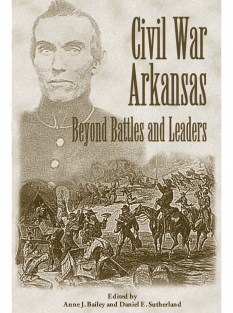With the goal of sketching “at least some of the bright lights and dark shadows of the war;” William Baxter authored his regional classic, Pea Ridge and Prairie Grove, in 1864, before the actual end of the Civil War.
Primarily focusing on the civilians of the region, Baxter vividly describes their precarious and vulnerable positions during the advances and retreats of armies as Confederate and Federal forces marched across their homeland. In his account, Baxter describes skirmishes and cavalry charges outside his front door, the “firing” of his town’s buildings during a Confederate retreat, clashes between secessionist and Unionist neighbors, the feeding of hungry soldiers and the forceful appropriation of his remaining food supply, and the sickening sight of the wounded emerging from the Prairie Grove battlefield.
Since its original printing, this firsthand account has only been reprinted once, in 1957, and both editions are considered collectors’ items today. Of interest to Civil War scholars and general readers alike, Baxter’s compelling social history is rendered even more comprehensive by William Shea’s introduction. Pea Ridge and Prairie Grove is a valuable personal account of the Civil War in the Trans-Mississippi West which enables us to better comprehend the conflict as a whole and its devastating effect on the general populace of the war-torn portions of the country.
William Baxter was the president of Arkansas College and a clergyman in Fayetteville, Arkansas, when the Civil War started in 1861.
William L. Shea is a professor of history at the University of Arkansas at Monticello and coauthor of Pea Ridge: Civil War Campaign in the West.
“Baxter’s Pea Ridge and Prairie Grove should help readers understand the human dimension of the Civil War. His story is not about the strategy of generals and the movement of armies on maps, but rather about the destructive power of warfare.”
—Bobby Roberts, Director, Central Arkansas Library System and co-author of Portraits of Conflict (Texas), Portraits of Conflict (Mississippi), Portraits of Conflict (Arkansas), Portraits of Conflict (Louisiana)
“The Civil War in the West has a single goal: to promote historical writing about the war in the western states and territories. It focuses most particularly on the Trans-Mississippi theater, which consisted of Missouri, Arkansas, Texas, most of Louisiana (west of the Mississippi River), Indian Territory (modern day Oklahoma), and Arizona Territory (two-fifths of modern day Arizona and New Mexico) but encompasses adjacent states, such as Kansas, Tennessee, and Mississippi, that directly influenced the Trans-Mississippi war. It is a wide swath, to be sure, but one too often ignored by historians and, consequently, too little understood and appreciated.
Topically, the series embraces all aspects of the wartime story. Military history in its many guises, from the strategies of generals to the daily lives of common soldiers, forms an important part of that story, but so, too, do the numerous and complex political, economic, social, and diplomatic dimensions of the war. The series also provides a variety of perspectives on these topics. Most importantly, it offers the best in modern scholarship, with thoughtful, challenging monographs.
Secondly, it presents new editions of important books that have gone out of print. And thirdly, it premieres expertly edited correspondence, diaries, reminiscences, and other writings by participants in the war.
It is a formidable challenge, but by focusing on some of the least familiar dimensions of the conflict, The Civil War in the West significantly broadens our understanding of the nation’s most pivotal and dramatic story.”
—Daniel Sutherland, from the preface of I Do Wish This Cruel War Was Over
“This book is a window into a time and place, from a point of view too often neglected. Baxter’s account, flawed as it is, has value for scholars today. Baxter describes the human side of war, what happens to people who have no idea what will come next and are powerless to alter events. … Pea Ridge and Prairie Grove makes an excellent addition to the “Civil War in the West” series and anyone interested in civilian life and the Trans-Mississippi will want to examine this short work.”
—The Civil War News


